New College, Oxford

Multi tool use
| New College | ||||||||||||
|---|---|---|---|---|---|---|---|---|---|---|---|---|
| Oxford | ||||||||||||
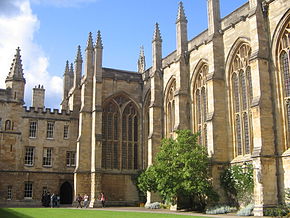 | ||||||||||||
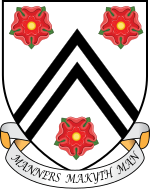 Blazon: Arms of New College Oxford (arms of William of Wykeham): Argent, two chevronels sable between three roses gules barbed and seeded proper. | ||||||||||||
| Location | Holywell Street and New College Lane | |||||||||||
| Coordinates | 51°45′15″N 1°15′05″W / 51.754277°N 1.251288°W / 51.754277; -1.251288Coordinates: 51°45′15″N 1°15′05″W / 51.754277°N 1.251288°W / 51.754277; -1.251288 | |||||||||||
| Full name | St Mary's College of Winchester in Oxford | |||||||||||
| Latin name | Collegium Novum Oxoniense/Collegium Sanctae Mariae Wintoniae | |||||||||||
| Motto | Manners Makyth Man | |||||||||||
| Established | 1379 (1379) | |||||||||||
| Named for | St. Mary | |||||||||||
| Sister college | King's College, Cambridge | |||||||||||
| Warden | Miles Young[1] | |||||||||||
| Undergraduates | 422[2] (2011/2012) | |||||||||||
| Postgraduates | 287 | |||||||||||
| Major events | Commemoration Ball 2016 | |||||||||||
| Grace | Benedictus benedicat. May the Blessed One give a blessing Benedicto benedicatur. Let praise be given to the Blessed One | |||||||||||
| Website | College website | |||||||||||
| Boat club | Boat Club | |||||||||||
| Map | ||||||||||||
 Location in Oxford city centre | ||||||||||||
New College is one of the constituent colleges of the University of Oxford in the United Kingdom. Founded in 1379 by William of Wykeham, the full name of the college is St Mary's College of Winchester in Oxford. The name "New College", however, soon came to be used following its completion in 1386 to distinguish it from the older existing college of St. Mary, now known as Oriel College.[3]
In 2017, the college ranked first[4] in the Norrington Table, a table assessing the relative performance of Oxford's undergraduates in final examinations. Historically, it has been ranked highly. It has the 3rd highest average Norrington Table ranking over the previous decade.[5] The college is between Holywell Street and New College Lane (known for Oxford's Bridge of Sighs), next to All Souls College, Harris Manchester College, Hertford College, The Queen's College and St Edmund Hall. The college's sister college is King's College, Cambridge.
The college is one of the main choral foundations of the University of Oxford. The college choir is regarded as one of the leading choirs of the world, and has recorded over one hundred albums;[6] it has been awarded two Gramophone Awards.
Like many of Oxford's colleges, New College admitted its first mixed-sex cohort in 1979, after six centuries as an institution for men only.[7]
New College is one of the wealthiest colleges in Oxford University. As of July 2017, it had a financial endowment in excess of £243 million, and net assets of over £286 million.[8]
Contents
1 History
1.1 Founding
1.2 Civil war
1.3 Motto
2 College links
3 Buildings and gardens
3.1 Hall
3.2 Chapel
3.3 City wall
3.4 Savile Road site
3.5 Gardens
4 Choir
4.1 Organ
4.2 Organists and directors of music
5 Student life
5.1 Middle Common Room
5.2 Junior Common Room
5.3 Rowing
6 People associated with the college
6.1 Alumni and fellows
6.2 Wardens
7 Gallery
8 References
9 Bibliography
10 External links
History
Despite its name, New College is one of the oldest of the Oxford colleges; it was founded in 1379 by William of Wykeham, Bishop of Winchester, as "The College of St Mary of Winchester in Oxford", the second college in Oxford to be dedicated to the Blessed Virgin Mary.
Founding
In 1379 William of Wykeham had purchased land in Oxford and was able to apply to King Richard II for a charter to allow the foundation of a college de novo.[9] In his own charter of foundation, Wykeham declared the college to consist of a warden and seventy scholars. The site on which the college would be built was acquired from several sources, including the City of Oxford, Merton College and Queen's College. This land had been the City Ditch, a haunt of thieves, and had been used for burials during the Black Death.[10]
New College was founded in conjunction with Winchester College (opened 1394), which was envisaged as a feeder to the Oxford college, and the two institutions have striking architectural similarities: both were the work of master mason William Wynford. On 5 March 1380, the first stone of New College was laid. By 14 April 1386, the college entered formal possession of the buildings. Wykeham set to drawing up the statutes of the college, with a first draft presented in 1390. The statutes were not completed until the year before Wykeham died (1404).
The coat of arms of the college is one adopted by William Wykeham. It features two black chevrons, one said to have been added when he became a bishop and the other representing his skill with architecture (the chevron was a device used by masons). Winchester College uses the same arms.[11]
The grand collection of buildings is a testament to William's experience in administering both ecclesiastical and civil institutions as the Bishop of Winchester and High Chancellor of England.
Both Winchester College and New College were originally established for the education of priests, there being a shortage of properly educated clergy after the Black Death. William of Wykeham ordained that there were to be ten chaplains, three clerks and 16 choristers on the foundation of the college.[12]
The original choristers were accommodated within the walls of the college under one schoolmaster. Since then the school has expanded and in 1903 moved to New College School in Savile Road.[13]
As well as being the first Oxford college for undergraduates and the first to have senior members of the college give tutorials,[14] New College was the first college in Oxford to be deliberately designed around a main quadrangle.[15]
Civil war
In August 1651, New College was fortified by the Parliamentarian forces and the cloister was used for musketry training. In 1685, Monmouth's rebellion involved Robert Sewster, a fellow of the college, who commanded a company of university volunteers. These volunteers were mostly of New College and exercised in the Bowling Green.[16]
Motto
The college's motto, created by William of Wykeham, is "Manners Makyth Man". The motto was in many respects fairly revolutionary. First, it was written in English, rather than Latin, which makes it very unusual in Oxford, and is especially revolutionary considering the college's age; even St Catherine's College, founded in 1965, has a Latin motto ("Nova et Vetera": "the new and the old"). Secondly, the motto makes a social statement; it is not by birth, money, or property that an individual is defined, but by how he or she behaves towards other people. Wykeham's motto is reminiscent of the insight found in Aristotle's Ethics,: that a man or a woman is what he or she does, and what we do is what we are.
College links
Admiring William of Wykeham's achievements in creating his twinned institutions, King Henry VI modelled the establishment of his own new colleges, King's College, Cambridge, and Eton College, upon Wykeham's foundations of New College and Winchester College.[17]
Indeed, the link that King's College, Cambridge, and Eton College share is a direct copy of William of Wykeham's link between New College and Winchester College.[18]
New College has formal ties with Winchester College, Eton College, and King's College, Cambridge, dating back to 1444, a four-way relationship known as the Amicabilis Concordia.[19][20]
Some formal ties continue to this day: King's is New College's official sister college. There exist, however, few continued links between New College and Winchester, excepting the presence of some of its fellows on the school's similarly constituted governing body of a Warden and Fellows.
Buildings and gardens
At the time of its founding, the college was a grand example of the "perpendicular style", with the closest resembling college being Merton.[21] New College was larger than all of the (six) existing Oxford colleges combined.
[22] At this time, the Quadrangle did not have the upper storey seen today, and the cloisters and bell-tower were added later, completed in 1400. The upper storey was added in the sixteenth century as attics which, in 1674, were replaced by a third storey as seen today. Also, the oval turf is an eighteenth-century addition.[21]
Many of its buildings are listed as being of special architectural or historical importance[23] and, today, the college is one of Oxford's most widely visited.[24] The college's grounds are among the largest of the Oxford University colleges.
Hall

Hall
The hall is the dining room of the college and its dimensions are eighty feet by forty feet (24 m × 12 m). In his charter, Wykeham forbade wrestling, dancing and all noisy games in the hall due to the close proximity of the college chapel, and prescribed the use of Latin in conversation.[21]
The panelling was added when Archbishop Warham was bursar of the college. The marble flooring replaced the original flooring in 1722. The open oak roof had been replaced by a ceiling at the end of the 18th century, and little is known of it. It was not until the Junior Common Room offered £1000 to restore the hall roof that work began on the roof seen today; this was in 1865 under the architect Sir Gilbert Scott. The windows were replaced at the time with painted glass and the portraits moved to a higher level. The hall underwent a major restoration project and reopened in January 2015.
Chapel

The altar and reredos

Looking back towards the entrance and organ
The cloisters and the chapel are of particular note;[25] much of the medieval stained glass in the ante-chapel was restored in a 20 year project which was commended in the 2007 Oxford Preservation Trust Environmental Awards.[26] Renowned for its grand interior, some of the stained glass windows were designed by the 18th-century portraitist Sir Joshua Reynolds[27] and contains works by Sir Jacob Epstein and El Greco.[28] For example, the Great West window shows a design by Sir Joshua Reynolds.
The organ was built by the firm of Grant, Degens, and Bradbeer in 1969, in a case designed by George Pace; somewhat revolutionary at the time, the instrument remains no less remarkable and idiosyncratic today. The choir stalls contain 62 14th-century misericords which are of outstanding beauty — several of New College's misericords were copied during the Victorian era, for use at Canterbury Cathedral. The niches of the reredos were provided by Sir Gilbert Scott and were fitted with statues in the 19th century.[21] Near the east end of the chapel is the Founder's Crosier, a relic overlaid with silver gilt and enamel that resembles a pastoral staff. This was exhibited at South Kensington in 1862.[29]
The bell tower contains one of the oldest rings of ten bells, which is rung by the Oxford Society of Change Ringers and the Oxford University Society of Change Ringers.
City wall

Entrance arch to the college gardens
The ancient Oxford City Wall, belonging to New College, is often noted. When William of Wykeham acquired the land on which to build the college, he agreed to maintain the city wall.[30] Every three years the Lord Mayor and Corporation of the City of Oxford take a walk along the wall to make sure that the obligation is being fulfilled, a tradition dating back to the college's foundation in 1379.[31]
Savile Road site
The Gradel Quadrangles were designed by David Kohn
and received planning permission in June 2018. They will provide an additional 70 student rooms, a flexible learning hub and a performance base on a site on the corner of Mansfield Road and Savile Road.[32]
Gardens
The Middle Gateway opens to the Garden Quadrangle, said to be modelled on the Palace of Versailles.[33] The gardens of New College include a mound that was arranged in the sixteenth century (which originally had steps, but is now smooth with one set of stairs). In a 1761 edition of Pocket Companion for Oxford the mound is described:
- "In the middle of the Garden is a beautiful Mount with an easy ascent to the top of it, and the Walks around it, as well as the Summit of it, guarded with Yew Hedges. The Area before the Mount being divided into four Quarters, [..] the King's Arms, [..] opposite to it the Founder's; in the third a Sun Dial; and the Fourth, a Garden-Knot, all planted in Box, and neatly cut."
They also boast the largest herbaceous border within two hundred yards of the college. Just over two hundred yards away is Rhodes House, where the largest herbaceous border in Oxford is located.[34] Despite tour guides regularly claiming New College has the largest herbaceous border in the UK, Dirleton Castle in Scotland[35] holds the accolade.
The college is also in possession of a large collection of silver (including the medieval silver gilt Founder's Crosier, housed in a display case in the chapel), the Oxford Chest which is currently in the Ashmolean Museum and two "unicorn horns" (which are in fact narwhal tusks). The library once contained a copy of the first print of Aristotle.[21]
Choir

New College Choir recording an English edition of Joseph Haydn's oratorio The Creation (2008)
As part of the original college statutes, William of Wykeham provided for a choral foundation of lay and academical clerks, with boy choristers to sing mass and the daily offices. It is a tradition that continues today with the choral services of evensong and Eucharist during term. In the Middle Ages choristers not only sang, but waited in hall, fetching beer for the students.
In addition to its choral duties in the chapel, the New College Choir has established a reputation as one of the finest Anglican choirs in the world and is known particularly for its performances of Renaissance and Baroque music.[36] Some seventy recordings of the choir are still in the catalogue[37] and as well as appearing a number of times at the BBC Proms, the choir make numerous concert tours.[38]
In 1997, the choir won a Gramophone Award in the best-selling disc category for their album Agnus Dei,[39] and in 2008, they won a Gramophone Award in the early music category for their recording of Nicholas Ludford's Missa Benedicta.[40]Edward Higginbottom, organist and tutor in music at New College until the end of the 2013–14 academic year, has been made Oxford University's first choral professor.[41]
The choristers are educated at New College School on Savile Road, a short distance from New College itself.
On Thursday 21 May 2009, the choir revived an ancient custom of processing to Bartlemas Chapel for a ceremony and then on to the location of an ancient spring. The ceremony had not been observed for the past 400 years.[42]
On 29 June 2015 and 2016, at the invitation of the Holy See and the Cappella Musicale Pontificia Sistina, the choir sang at the Papal Pallium mass for the Solemnity of Saints Peter and Paul in St. Peter's Basilica.[43][44][45]
Organ
The original organ was given by William Porte (1420–3) and is mentioned in the poem Musae Hospitales of 1610.[46] The present instrument was constructed by Grant, Degens and Bradbeer in 1969.[47] Tuning is regulated by Bishop and Son of London and Ipswich. In the summer of 2014 the organ was restored, with the key actions and other mechanisms being completely renewed by Goetze and Gwynn, and minor registration changes also made, including the 32 ft Fagot receiving a full-length bass (previously half-length).[48] The remaining restoration works were to be completed before the start of Hilary Term 2015.
Organists and directors of music
- 1694 John Weldon
- 1776 Philip Hayes[49]
- 1825 Alfred Bennett
- 1830–60 Stephen Elvey[49]
- -1869 G. B. Arnold[49]
- 1870 James Taylor[49]
- 1901 Hugh Allen
- 1919 William Henry Harris[50]
- 1929 John Dykes Bower[50]
- 1933 Sydney Watson[50]
- 1938 Herbert Kennedy Andrews[50]
- 1956 Meredith Davies
- 1959 David Lumsden
- 1976 Edward Higginbottom
- 2014 Robert Quinney
Student life
Middle Common Room
The Middle Common Room (MCR i.e. the graduate member of the college) is very active. The common room itself and the MCR bar are located in the Weston Buildings by the New College sports grounds and some of the graduate accommodation. Alongside a variety of social events, the MCR also holds graduate colloquia and produces its own journal (the New Collection[51]) to share the wide range of research of its members.
Junior Common Room
The Junior Common Room (JCR) refers to the body of undergraduates at the college. It has a committee of elected and appointed members. Positions which are held include the President, Vice President, welfare representatives (reps) for male, female and non-binary genders, LGBTQ and BME students, a women's officer, charities rep, MADD rep, access rep, international rep, food and bar rep, housing rep, treasurer, environment and ethics rep, academic affairs rep and entz reps. There are also several non-committee roles such as officers for board games, bicycles, IT, band room and wine steward.[52] An unusual appointed position in the JCR is that of Mint Julep Quarterperson, who is tasked with providing free mint julep cocktails to all members on 1 June to commemorate the anniversary of the visit of William Trapier to the college in 1845. He was shocked that the college butler had never heard of the drink, and so made one himself from ingredients which he found, and then left a fund so that every year, members of the college could enjoy a mint julep on the anniversary of his visit from America. The quarterperson is tasked with organising the continuation of this tradition each year.
Rowing

New College at the 1912 Summer Olympics
New College is one of only a few Oxford or Cambridge colleges to have won an Olympic medal; the New College Boat Club represented Great Britain at the Summer Olympics in Stockholm, Sweden, in 1912, and earned a silver medal.[53]
In 1912, Great Britain sent two men's crews to the Olympics in Stockholm, Sweden. One was a Leander crew, composed mostly of Magdalen College (Oxford) rowers, and captained by the Magdalen captain. The second was the New College 1st VIII.
The two British crews were the favourites for gold so started at opposite ends of the draw. They both worked up through the competition to make the final. The course in Stockholm was not straight, and one of the two lanes was clearly favoured, the other requiring the cox to steer around a protruding boathouse and then back under a bridge.[54]
Before the final, the two British captains met to toss for lanes. New College won the toss and following gentlemanly tradition offered the choice of lanes to their opponents, who would — in a gentlemanly fashion — refuse this offer. However the Leander/Magdalen captain accepted this offer and chose the better lane. Leander went on to win the gold medal, leaving New College with the silver.
King Gustav V of Sweden was so disheartened by this display of ungentlemanly conduct that, as a consolation, he presented his colours to New College. Ever since then, New College have raced in purple and gold, the colours of the royal house of Sweden.[citation needed] A further tradition has been the adoption of the toast: "God damn bloody Magdalen!", the supposed words of the New College stroke Robert Bourne as they crossed the line. The abbreviation "GDBM" is still used commonly, being on the bottom of the NCBC letterhead to this day. Today, the New College Olympic blade may be viewed on display at the Olympic Museum in Lausanne, Switzerland.
New College Boat Club is also one of the few Oxford clubs to have held both headships at Summer Eights (though not in the same year), and one of only 11 Oxford or Cambridge colleges to have won the Grand Challenge Cup at Henley Royal Regatta, having also won the Visitor Challenge Cup twice, the Ladies Challenge Plate twice and the Stewards' Challenge Cup twice.[55]
People associated with the college
Alumni and fellows

Simon Baron-Cohen

Kate Beckinsale

Peter Bergen

Henry Chichele

Edgeworth David

Richard Dawkins

Robin Lane Fox

Hugh Gaitskell

Hugh Grant

Irfan Habib

J. B. S. Haldane

G. H. Hardy

William Howley

Sophie Kinsella

Susan Rice
Marcus du Sautoy

Tony Benn
New College has a legacy of notable individuals who have studied and worked at the college. Among them are Nobel Prize winners, churchmen, statesmen, leading scientists and literary figures.
The Simonyi Professorship of the Public Understanding of Science was held by Richard Dawkins and is now held by Marcus du Sautoy, both of whom are fellows of New College.[56]
Wardens
The warden is the college's principal, responsible for its academic leadership, chairing its governing body and representing the college internationally.
Gallery

Photo-chrome of the college

Holywell Street, New College, Oxford
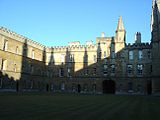
The old quad of New College, Oxford
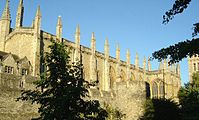
Chapel and city wall

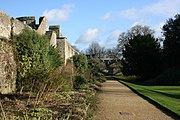
College gardens

Cloisters
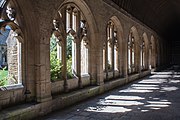
Cloisters
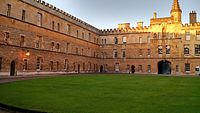
References
^ "New College, Oxford: Appointment of Next Warden". Archived from the original on 18 June 2015. Retrieved 16 June 2015..mw-parser-output cite.citationfont-style:inherit.mw-parser-output .citation qquotes:"""""""'""'".mw-parser-output .citation .cs1-lock-free abackground:url("//upload.wikimedia.org/wikipedia/commons/thumb/6/65/Lock-green.svg/9px-Lock-green.svg.png")no-repeat;background-position:right .1em center.mw-parser-output .citation .cs1-lock-limited a,.mw-parser-output .citation .cs1-lock-registration abackground:url("//upload.wikimedia.org/wikipedia/commons/thumb/d/d6/Lock-gray-alt-2.svg/9px-Lock-gray-alt-2.svg.png")no-repeat;background-position:right .1em center.mw-parser-output .citation .cs1-lock-subscription abackground:url("//upload.wikimedia.org/wikipedia/commons/thumb/a/aa/Lock-red-alt-2.svg/9px-Lock-red-alt-2.svg.png")no-repeat;background-position:right .1em center.mw-parser-output .cs1-subscription,.mw-parser-output .cs1-registrationcolor:#555.mw-parser-output .cs1-subscription span,.mw-parser-output .cs1-registration spanborder-bottom:1px dotted;cursor:help.mw-parser-output .cs1-ws-icon abackground:url("//upload.wikimedia.org/wikipedia/commons/thumb/4/4c/Wikisource-logo.svg/12px-Wikisource-logo.svg.png")no-repeat;background-position:right .1em center.mw-parser-output code.cs1-codecolor:inherit;background:inherit;border:inherit;padding:inherit.mw-parser-output .cs1-hidden-errordisplay:none;font-size:100%.mw-parser-output .cs1-visible-errorfont-size:100%.mw-parser-output .cs1-maintdisplay:none;color:#33aa33;margin-left:0.3em.mw-parser-output .cs1-subscription,.mw-parser-output .cs1-registration,.mw-parser-output .cs1-formatfont-size:95%.mw-parser-output .cs1-kern-left,.mw-parser-output .cs1-kern-wl-leftpadding-left:0.2em.mw-parser-output .cs1-kern-right,.mw-parser-output .cs1-kern-wl-rightpadding-right:0.2em
^ "Undergraduate numbers by college 2011–12". University of Oxford.
^ Buxton, pp. 7–8.
^ News, Cherwell (2017-08-11). "New College storms to top of Norrington Table". Cherwell.org. Retrieved 2017-08-11.
^ "Undergraduate Degree Classifications | University of Oxford". www.ox.ac.uk. Retrieved 2017-08-11.
^ "Shop". newcollegechoir.com. Archived from the original on 25 March 2012. Retrieved 13 June 2011.
^ "The History of New College | New College". www.new.ox.ac.uk. Archived from the original on 13 April 2018. Retrieved 4 May 2018.
^ "College Finances 20142" (PDF). Archived from the original (PDF) on 9 April 2018. Retrieved 6 April 2018.
^ Prickard, p.17
^ Prickard, p.25
^ Prickard, p.22
^ "History of Oxford New College school". Of Choristers – ancient and modern. Archived from the original on 9 January 2005. Retrieved 4 January 2009.
^ "New College School, Oxford". Archived from the original on 6 June 2013. Retrieved 4 January 2009.
^ Prickard, p.68-9
^ "New College Guide".
^ Prickard, p.72
^ Prickard, p.62
^ "Travel Through History — Henry VI". Archived from the original on 2007-10-26.
^ "KING'S COLLEGE PUBLICATION SCHEME". King's College, Cambridge, UK. Archived from the original on 2006-09-28.
^ Prickard, p.61
^ abcde Prickard, p.26-31
^ "New College, University of Oxford". Archived from the original on 24 December 2008.
^ Buildings listed as being of special architectural or historical importance by the public body Historic England:
"WALL, SOUTH OF BASTION 15". Listing. Historic England. Retrieved 18 September 2016.
"WALL TO EAST OF BELL TOWER". Listing. Historic England. Retrieved 18 September 2016.
"BASTION 12 IN NEW COLLEGE". Listing. Historic England. Retrieved 18 September 2016.
"BASTION 13". Listing. Historic England. Retrieved 18 September 2016.
"WALL SOUTH OF BASTION 14". Listing. Historic England. Retrieved 18 September 2016.
"NEW COLLEGE, WEST RANGE, GREAT QUADRANGLE". Listing. Historic England. Retrieved 18 September 2016.
"NEW COLLEGE OXFORD, CLOISTER (TO WEST OF CHAPEL)". Listing. Historic England. Retrieved 18 September 2016.
"NEW COLLEGE, NORTH RANGE". Listing. Historic England. Retrieved 18 September 2016.
"NEW COLLEGE, IRON SCREEN". Listing. Historic England. Retrieved 18 September 2016.
"NEW COLLEGE, TUTORS HOUSE (TO THE EAST OF THE PANDY)". Listing. Historic England. Retrieved 18 September 2016.
"WALL TO EAST OF BASTION 11". Listing. Historic England. Retrieved 18 September 2016.
"WALL EAST OF BASTION 12". Listing. Historic England. Retrieved 18 September 2016.
"BASTION 14, ON NORTH EAST ANGLE OF WALL". Listing. Historic England. Retrieved 18 September 2016.
"BASTION 15". Listing. Historic England. Retrieved 18 September 2016.
"NEW COLLEGE, SOUTH RANGE, GREAT QUADRANGLE". Listing. Historic England. Retrieved 18 September 2016.
"NEW COLLEGE, NORTH RANGE HALL, KITCHEN AND CHAPEL, GREAT QUADRANGLE". Listing. Historic England. Retrieved 18 September 2016.
"NEW COLLEGE, BELL TOWER". Listing. Historic England. Retrieved 18 September 2016.
"NEW COLLEGE, BOUNDARY WALL FRONTING NEW COLLEGE LANE AND QUEENS LANE". Listing. Historic England. Retrieved 18 September 2016.
"NEW COLLEGE, NEW BUILDINGS". Listing. Historic England. Retrieved 18 September 2016.
"NEW COLLEGE, SOUTH RANGE". Listing. Historic England. Retrieved 18 September 2016.
"NEW COLLEGE, EAST RANGE, GREAT QUADRANGLE". Listing. Historic England. Retrieved 18 September 2016.
"NEW COLLEGE, THE WARDENS BARN". Listing. Historic England. Retrieved 18 September 2016.
"NEW COLLEGE, THE LONGHOUSE". Listing. Historic England. Retrieved 18 September 2016.
"BASTION 11". Listing. Historic England. Retrieved 18 September 2016.
"WALL, EAST OF BASTION 13". Listing. Historic England. Retrieved 18 September 2016.
"WALL, SOUTH OF BASTION 15". Listing. Historic England. Retrieved 18 September 2016.
^ "Most widely-visited Oxford Colleges".
^ "The Chapel and Choir". Archived from the original on 29 December 2008.
^ "Glazier's Magnificent Seven". oxfordtimes.co.uk. Retrieved 22 February 2019.
^ "New York Times Guide". The New York Times. 9 May 1982. Retrieved 20 May 2010.
^ "Travel Guide".
[permanent dead link]
^ Prickard, p.39
^ Prickard, p.53
^ "Guide to Oxford sights".
^ "The Gradel Quadrangles". new.ox.ac.uk. Retrieved on 2018-08-08.
^ Prichard, p.41
^ "Rhodes House News". Archived from the original on 16 July 2011. Retrieved 1 April 2013.
^ "Castles in Edinburgh". Archived from the original on 25 September 2011. Retrieved 1 April 2013.
^ Stevenson, Joseph. "Edward Higginbottom". Allmusic.com.
^ "Discography". New College Choir, Oxford. New College, Oxford. Archived from the original on 4 March 2016. Retrieved 17 August 2015.
^ "The Choir of New College Oxford". Archived from the original on 7 March 2009.
^ Gramophone 1997 Awards
^ Gramophone 2008 Awards
^ "New College Choir main page". Archived from the original on 27 October 2005. Retrieved 16 November 2005.
^ "Choir revives 16th century custom". BBC News. 21 May 2009. Retrieved 21 May 2009.
^ "Pope welcomes Orthodox delegation for feast of Sts Peter and Paul: Choristers of the Anglican choir of New College, Oxford, sing during Mass". Efpastoremeritus2. Archived from the original on 13 August 2015. Retrieved 17 August 2015.
^ Glatz, Carol (30 Jun 2015). "Archbishops who attended pallium Mass struck by sense of unity". Catholic Herald. Retrieved 17 August 2015.
^ "Papal Pallium Mass – St. Peters Basilica". allevents.in.
^ Prickard, p.36
^ Organ, New College Choir Archived 25 March 2012 at the Wayback Machine. Retrieved 1 May 2010
^ "News & Events – Choir of New College Oxford". newcollegechoir.com. Archived from the original on 5 December 2014. Retrieved 29 November 2014.
^ abcd http://www.ofchoristers.net/Chapters/OxfordNewCollege.htm[permanent dead link]. Retrieved 1 May 2010.
^ abcd "Archived copy". Archived from the original on 3 December 2008. Retrieved 1 May 2010.CS1 maint: Archived copy as title (link). Retrieved 1 May 2010
^ "The New Collection". ox.ac.uk.
^ "New College JCR". jcr.new.ox.ac.uk.
^ "The Fifth Olympiad – Official Report of the Olympic Games of Stockholm 1912 (Swedish Olympic Committee 1913) pp.662–667".
^ "The Fifth Olympiad – Official Report of the Olympic Games of Stockholm 1912 (Swedish Olympic Committee 1913) pp.659–660".
^ "New College Boat Club". Archived from the original on 8 September 2008.
^ "Academic Staff". Archived from the original on 2008-04-23. Retrieved 2008-03-27.
Bibliography
Buxton, John, and Penry Williams (1979). New College, Oxford, 1379–1979. Oxford: Warden and Fellows of New College.
ISBN 978-0950651002.
Halford Smith, Alic (1952). New College, Oxford, and its Buildings. Oxford: Oxford University Press.- Jenkinson, Matthew (2013). New College School, Oxford: A History. Oxford: Shire.
ISBN 978-0747813415.
Prickard, Arthur Octavius (1906). New College, Oxford. London: J.M. Dent.- Tyerman, Christopher (2010). New College. London: Third Millennium.
ISBN 978-1906507213.
External links
| Wikimedia Commons has media related to New College, Oxford. |
Wikisource has original text related to this article: New College, as described in "Literary Landmarks of Oxford." |
- New College JCR, Oxford
- New College MCR, Oxford
- College choir
- New College School
waBLb,EsrWY2ZftTLbdkbgyk mCRT,QNt


























